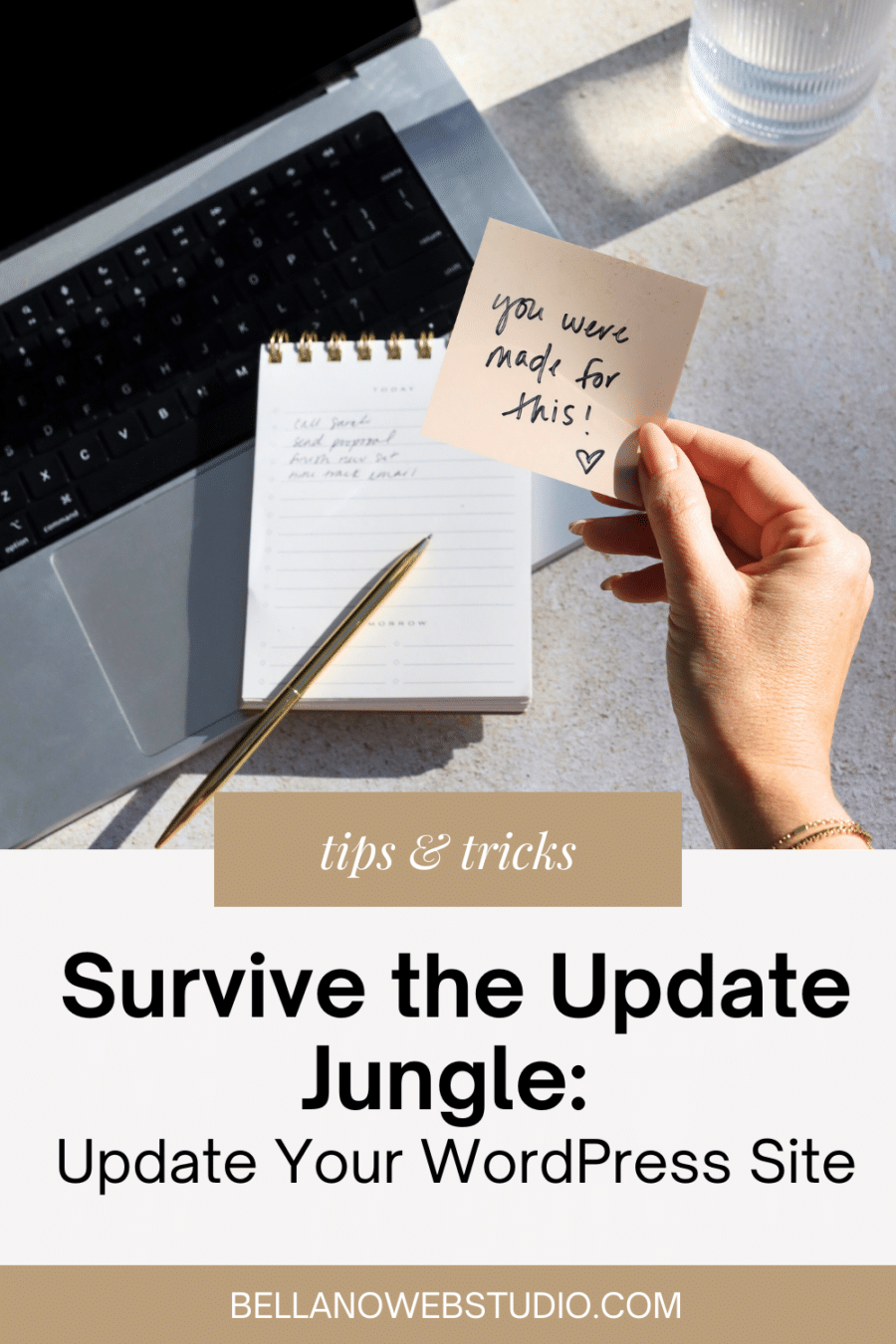Survive the Update Jungle: Update Your WordPress Site
Feeling Nervous About WordPress Updates?
Does the thought of hitting the “update” button on your WordPress site make you anxious? Trust me, you’re not alone. Many of us worry about the potential glitches that can come with updates… even me! But fear not—I’ve got some handy tips on how to update WordPress core, themes, and plugins safely to make this process smoother than a fresh jar of Skippy (head nod to Bruno Mars).
Always Be Prepared
Before you do anything, make sure you run a backup. It’s like having a safety net while performing a high-wire act. I like to run my updates first thing in the morning before I do anything on my site, ensuring I have a fresh overnight backup.
If your host does not run overnight backups, I recommend adding BlogVault (or a similar service), setting up nightly backups, and familiarizing yourself with the ‘restore’ feature. Knowing you can restore your site if something goes wrong takes the stress out of hitting that update button for WordPress core, themes, and plugins.
My Top Hosting Pick: Flywheel
After sailing through the vast sea of web hosting providers, there’s one that stands out like a lighthouse for me – Flywheel. This is my go-to choice, both for my business and my clients. Flywheel is, hands down, the best-managed WordPress hosting service for busy creatives that I’ve had the pleasure of using.
Overnight backups and One-Click Restore are only two of my must-have features for hosting…and Flywheel makes both sooooo easy!
Flywheel not only ticks all the boxes on my key factors list, but it also goes above and beyond. They understand that when you’re busy creating, you need a web host that can manage the technical stuff with ease. And their customer service? Simply unmatched! Their dedicated team is always ready to step in, guide, and assist you whenever you need help.
So, if you’re a busy creative looking for a web hosting service that truly understands and caters to your needs, Flywheel could be your perfect match.
Timing is Everything
Here’s a little nugget of wisdom from my own experience—don’t rush the big, flashy updates. For instance, when WordPress releases a major update like 6.5, it’s tempting to jump right in. However, I recommend waiting for the next iteration, say 6.5.1. These updates often include fixes for any bugs that might have slipped through the cracks in the initial release.
Currently, we’re at 6.5.5, which means it’s a green light for updating if you’ve been holding off!
Look Out for Major Changes
When WordPress moves to 6.6, wait for 6.6.1 or even 6.6.2. And when they update to a whole number, like from 6 to 7, I would wait for 7.1 or 7.2 just to be safe. These minor updates are your best friend because they smooth out the initial bumps of a major release.
Examples to Guide You
This rule of thumb isn’t just for WordPress itself. It applies to Kadence, WooCommerce, Yoast SEO, and all of your plugins and themes. If Kadence rolls out a major new version, wait a bit for a minor update that tweaks and perfects. The same goes for WooCommerce and Yoast SEO—after a significant release, give it a bit for a patch to follow to always ensure that the new versions play nicely with the current WordPress version.
That 3rd Decimal is a Green Light
Updates that change from, say, 6.5.0 to 6.5.2 are your cue to go ahead. These versions are usually bug and/or security fixes. Think of the 3rd decimal as the universe giving you the thumbs up to proceed with confidence. This understanding is critical for anyone looking for how to update WordPress core, themes, and plugins safely.
Why So Many Updates?
It’s a domino effect. When WordPress releases an update, often introducing new features, it can inadvertently introduce bugs in plugins or your theme which triggers further updates. Every theme and plugin linked to WordPress must also be updated to ensure compatibility and smooth functionality. These updates are essential for keeping your site secure and performing well. So, while frequent updates might seem daunting or even annoying, they’re vital for maintaining your site’s health and efficiency, and ensuring you have the latest features at your disposal.
Make It a Routine
I strongly encourage you to dedicate a regular time each week for updates. This practice will keep your site up-to-date and running smoothly and prevents a backlog of updates that can become overwhelming. If updates start to accumulate—say you have more than five—tackle them in smaller batches. Update a few, then refresh your site to ensure everything looks and functions as it should before proceeding.
I have learned to pay special attention to those related to Kadence, WooCommerce, and Yoast SEO. I recommend handling them individually to avoid conflicts and ensure a seamless integration. This approach minimizes disruptions and maintains the integrity of your website’s performance.
Wrapping Up
Keeping up with your updates shouldn’t be a chore or a fear-inducing task. With these simple steps, you can ensure your site remains as stunning and effective as the day it went live. Remember, a well-maintained site is like a well-oiled machine—it runs better and lasts longer!
By following these tips and making regular updates a part of your routine, you can master how to update WordPress core, themes, and plugins safely and ensure your WordPress site remains in top shape, ready to impress visitors and support your business goals. Happy updating!
More WordPress Tips:
Did you find this post helpful?
Share the love and save it to Pinterest!









